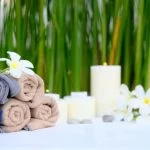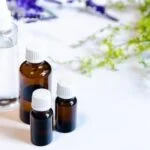Are you wondering how to mix aromatherapy oils for massage? Aromatherapy has long been used as a natural way to promote relaxation, reduce stress, and improve overall wellness.
In this article, we’ll explore the art of combining essential oils and carrier oils to create customized blends for use in massage therapy. Whether you’re a seasoned practitioner or new to the world of aromatherapy, understanding the properties of different oils and learning proper blending techniques can enhance your massage experience.
When it comes to aromatherapy massage, choosing the right carrier oil is essential for diluting essential oils and ensuring that they are safely applied to the skin. We will delve into the various carrier oils available and their unique benefits for use in massage therapy. Understanding the properties of essential oils is also crucial in creating effective blends for aromatherapy massage. We’ll discuss how different essential oils can address specific needs, such as relaxation, pain relief, or mental clarity.
Additionally, safety precautions for mixing aromatherapy oils should always be considered to avoid adverse reactions or sensitivities. In this article, we’ll provide valuable tips on handling and storing essential oils, as well as guidelines for safe dilution ratios. Whether you’re looking to enhance your massage practice or simply enjoy the benefits of aromatherapy at home, mastering the art of mixing aromatherapy oils can elevate your wellness routine.
Choosing the Right Carrier Oil for Aromatherapy Massage
When it comes to aromatherapy massage, choosing the right carrier oil is essential for creating the perfect blend. Carrier oils are used to dilute essential oils before applying them to the skin during a massage. They help to ensure that the essential oils are safe for use and also help to spread them evenly across the skin. Here are some common carrier oils that are popular for aromatherapy massage:
- Sweet Almond Oil: This oil is lightweight and easily absorbed by the skin, making it a popular choice for massage.
- Coconut Oil: Known for its moisturizing properties, coconut oil is also great for massage and can leave the skin feeling supple and hydrated.
- Grapeseed Oil: This light, odorless oil is great for sensitive skin and doesn’t leave a greasy feeling after application.
Understanding the properties of each carrier oil is important when choosing the right one for your aromatherapy blend. Some carrier oils have therapeutic properties of their own and can complement the effects of the essential oils being used. It’s also important to consider any allergies or sensitivities that you or your massage recipient may have when selecting a carrier oil.
When creating an aromatherapy massage blend, it’s important to take into account the specific needs and preferences of the individual receiving the massage. Some carrier oils have a longer shelf life than others, so this may also be a factor to consider when choosing the right one for your blend. Ultimately, selecting a carrier oil that meets both your practical needs and desired therapeutic effects will ensure a successful aromatherapy massage experience.
Understanding the Properties of Essential Oils for Aromatherapy Massage
When it comes to aromatherapy massage, understanding the properties of essential oils is crucial for creating blends that are both effective and safe. Essential oils are highly concentrated plant extracts that possess various therapeutic properties, including but not limited to anti-inflammatory, analgesic, antimicrobial, and relaxing effects. By understanding the properties of different essential oils, you can create blends that target specific concerns and offer a range of benefits during your massage sessions.
For example, lavender essential oil is well-known for its calming and stress-relieving properties, making it an excellent choice for promoting relaxation during a massage. On the other hand, peppermint essential oil has invigorating and cooling effects which can help soothe sore muscles and improve circulation. By familiarizing yourself with the properties of essential oils, you can select the ones that align with your massage goals and tailor your blends accordingly.
It’s also important to consider the safety aspects of essential oils when creating blends for aromatherapy massage. Some essential oils are phototoxic or may cause skin irritation if not properly diluted.
Others may not be suitable for use during pregnancy or by individuals with certain health conditions. By being knowledgeable about the properties of essential oils, you can make informed decisions about which ones to include in your blends and ensure that they are used safely and effectively during massage sessions.
Safety Precautions for Mixing Aromatherapy Oils
Know Your Oils
When mixing aromatherapy oils for massage, it’s essential to have a good understanding of the properties of each essential oil. Some oils can cause skin irritation or allergic reactions, especially when used in high concentrations. It’s important to research and familiarize yourself with the potential side effects of each oil before blending them together.
Additionally, some oils are not suitable for use during pregnancy or by individuals with certain health conditions. Being knowledgeable about the oils you are using will help ensure that you create safe and effective blends for massage.
Dilution Ratios
Safety precautions also include proper dilution ratios when mixing aromatherapy oils for massage. Essential oils are highly concentrated and should never be applied directly to the skin without being diluted first. Carrier oils, such as almond oil, coconut oil, or jojoba oil, are commonly used to dilute essential oils for massage.
The typical dilution ratio is 2-3 drops of essential oil per teaspoon of carrier oil for adults. However, this ratio may vary depending on the individual’s age, health condition, and the specific essential oils being used.
Patch Testing
Before using any new blend of aromatherapy oils for massage, it’s crucial to perform a patch test on a small area of the skin first. This helps to determine if there is any sensitivity or allergic reaction to the blend. Apply a small amount of diluted oil to the inner forearm and cover it with a bandage for 24 hours.
If no redness, itching, or irritation occurs during this time, it is likely safe to use the blend for massage. Patch testing is especially important when using new essential oils or blends, as everyone’s skin reacts differently.
Step-by-Step Guide on How to Mix Aromatherapy Oils for Massage
Gather Your Supplies
Before you begin mixing your aromatherapy oils for massage, make sure you have all the necessary supplies on hand. This includes your chosen carrier oil, essential oils, a clean glass bottle for storing the blend, and any additional tools like droppers or measuring spoons.
Choose Your Carrier Oil
The first step in mixing aromatherapy oils for massage is selecting a carrier oil. Popular options include sweet almond oil, coconut oil, jojoba oil, and grapeseed oil. Each carrier oil has its own unique properties and benefits, so consider the type of massage you’ll be giving and the skin type of the recipient when making your selection.
Add Essential Oils
Once you’ve chosen your carrier oil, you can start incorporating essential oils into the mix. Keep in mind that essential oils are highly concentrated, so a little goes a long way. For a full body massage blend, aim for a total of 15-20 drops of essential oil per 2 ounces of carrier oil. You can use a single essential oil or create a custom blend based on the recipient’s needs and preferences.
By following these steps, you can easily mix your own personalized aromatherapy oils for massage and provide a truly tailored and luxurious experience for yourself or your massage clients.
Tips for Customizing Aromatherapy Oil Blends
When it comes to customizing your aromatherapy oil blends for massage, there are a few key tips to keep in mind. First, it’s important to understand the properties of each essential oil you are working with. This will help you create blends that not only smell great but also provide the therapeutic benefits you are looking for. For example, lavender is known for its calming and relaxing properties, while eucalyptus is often used for its invigorating and decongestant effects.
Another tip is to consider the individual preferences and needs of the person receiving the aromatherapy massage. If they have any specific preferences for scents or if they are seeking relief from certain ailments, you can tailor the blend to suit their needs. Communication with your client is key in this aspect, as it allows you to create a customized experience that caters to their unique requirements.
It’s also important to experiment with different combinations of essential oils to find what works best for you and your clients. Keep track of the blends you create and take note of the feedback you receive. This will allow you to refine your techniques and develop a repertoire of customized aromatherapy oil blends that cater to a variety of needs and preferences.
| Tips | Details |
|---|---|
| Understand Essential Oil Properties | Learn how each essential oil affects mood and body |
| Consider Client Preferences | Customize based on scent preference or desired therapeutic effects |
| Experiment and Track Results | Try different combinations and keep notes on client feedback |
Different Techniques for Aromatherapy Massage
Aromatherapy massage is a popular holistic treatment that combines the therapeutic benefits of massage with the healing properties of essential oils. There are different techniques for administering aromatherapy massage, each with its own unique benefits and effects on the body and mind. Below are some common techniques used in aromatherapy massage:
- Effleurage: This technique involves long, sweeping strokes that glide over the skin using the hands or fingers. It helps to increase circulation and relax tense muscles, making it an effective way to begin an aromatherapy massage session.
- Petrissage: Petrissage consists of kneading, squeezing, and rolling movements that target deeper layers of muscle tissue. This technique can help relieve muscle tension and improve mobility, making it particularly beneficial for those experiencing muscle stiffness or pain.
- Friction: Friction involves applying pressure to specific points on the body using circular or back-and-forth movements. It can help break down scar tissue, improve joint flexibility, and alleviate localized pain and discomfort.
- Tapotement: Also known as percussion, tapotement involves rhythmic tapping or patting movements performed with the fingertips, palms, or sides of the hands. This technique can invigorate the body, stimulate circulation, and release tension.
Each of these techniques can be enhanced by incorporating customized aromatherapy oil blends tailored to address specific wellness goals or concerns. By combining the therapeutic benefits of touch with the healing properties of essential oils, aromatherapy massage offers a holistic approach to relaxation, rejuvenation, and overall well-being.
Benefits of Using Aromatherapy Oils for Massage
Aromatherapy oils have been used for centuries to enhance the massage experience and promote overall well-being. When used in conjunction with massage therapy, these essential oils can provide a range of benefits for both the body and the mind.
One of the main advantages of using aromatherapy oils for massage is their ability to create a more relaxing and soothing environment. The gentle fragrances of these oils can help to reduce stress, anxiety, and tension, allowing the recipient to fully unwind during the massage session.
In addition to their mood-boosting properties, aromatherapy oils can also have physical benefits for the body. Many essential oils have anti-inflammatory, antispasmodic, and analgesic properties that can help to alleviate muscle pain, improve circulation, and promote faster recovery from physical exertion. When carefully selected and blended with a carrier oil, these essential oils can target specific issues such as sore muscles, joint stiffness, or skin conditions like eczema or psoriasis.
Furthermore, using aromatherapy oils during massage can also enhance the overall therapeutic benefits of the treatment. Their aromatic compounds can stimulate the limbic system in the brain, which plays a role in emotions, behavior, motivation, long-term memory, and sense of smell.
This means that incorporating aromatherapy oils into a massage session can lead to not only physical relaxation but also mental clarity, improved focus, and an uplifted mood. Overall, harnessing the power of aromatherapy oils during a massage can truly elevate the entire experience for both clients and therapists alike.
Conclusion
In conclusion, incorporating aromatherapy oils into your massage experience can elevate the overall benefits and provide a more holistic approach to relaxation and wellness. By understanding the properties of different essential oils and choosing the right carrier oil, you can customize your massage oil blend to target specific needs such as stress relief, muscle relaxation, or even emotional balance.
It is important to keep safety precautions in mind when mixing aromatherapy oils, as some oils may cause irritation or allergic reactions if not used properly.
Following a step-by-step guide on how to mix aromatherapy oils for massage can help ensure that you achieve the desired scent and therapeutic effects. Additionally, customizing your oil blends allows for a personalized experience that caters to your individual preferences and needs. Whether you prefer a Swedish massage technique or enjoy the benefits of acupressure during your aromatherapy massage, there are various techniques that can be used to enhance the effectiveness of the essential oils.
Overall, using aromatherapy oils for massage offers numerous benefits including stress relief, relaxation, improved circulation, and even immune system support. The combination of touch therapy with the therapeutic properties of essential oils creates a powerful synergy that promotes both physical and mental well-being. By enhancing your massage experience with aromatherapy oils, you can fully immerse yourself in a multi-sensory journey towards improved health and vitality.
Frequently Asked Questions
How Do You Mix Essential Oils for Massage?
Mixing essential oils for massage requires careful consideration of the individual properties of each oil and the desired outcome. It’s important to dilute the essential oils in a carrier oil to prevent skin irritation or sensitivity.
Typically, 15-30 drops of essential oil are added to 1 ounce (30 mL) of carrier oil, but this can vary based on factors like the specific essential oils being used and the recipient’s preferences.
What Is the Ratio of Essential Oils to Massage Oil?
The ratio of essential oils to massage oil is typically around 2-3% dilution, meaning that for every ounce (30 mL) of carrier oil, you would add about 9-18 drops of essential oil. This ratio allows for a safe and effective use of the essential oils without overwhelming the mixture with their concentrated potency.
How Do You Combine Aromatherapy Oils?
When combining aromatherapy oils, it’s important to consider their individual scents, therapeutic properties, and potential interactions. Some oils may complement each other well while others may not mix harmoniously.
It’s also important to keep in mind the intended purpose of the blend – whether it’s relaxation, stimulation, respiratory support, or something else – and choose oils that align with those goals. Experimenting with different combinations and taking note of what works best for you is key in creating a personalized blend that meets your needs.

Are you looking for a natural way to improve your health and wellbeing?
If so, aromatherapy may be the answer for you.





